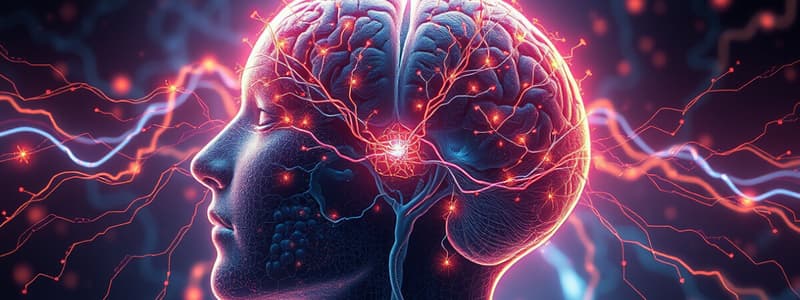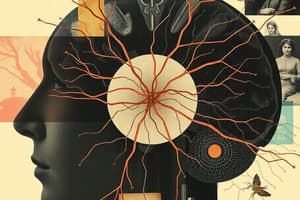Podcast
Questions and Answers
What primarily makes up white matter in the CNS?
What primarily makes up white matter in the CNS?
- Neurological cells
- Bundles of parallel axons (correct)
- Ganglia
- Clusters of neuron cell bodies
The sodium-potassium pump helps to maintain a higher concentration of Na⁺ inside the cell than outside.
The sodium-potassium pump helps to maintain a higher concentration of Na⁺ inside the cell than outside.
False (B)
What is the term used to describe the point of equilibrium where the tendency for K⁺ to move out is balanced by the negative charge inside the cell?
What is the term used to describe the point of equilibrium where the tendency for K⁺ to move out is balanced by the negative charge inside the cell?
Resting Membrane Potential
The type of channels that are always open and predominantly allow K⁺ to pass through are called ______ channels.
The type of channels that are always open and predominantly allow K⁺ to pass through are called ______ channels.
Match the following components of the nervous system with their descriptions:
Match the following components of the nervous system with their descriptions:
Which of the following gates sodium channels during an action potential?
Which of the following gates sodium channels during an action potential?
Depolarization refers to the inside of the cell becoming more negative.
Depolarization refers to the inside of the cell becoming more negative.
What process occurs when an action potential 'jumps' from one node of Ranvier to the next?
What process occurs when an action potential 'jumps' from one node of Ranvier to the next?
The synaptic cleft is the space between the presynaptic terminal and the postsynaptic membrane.
The synaptic cleft is the space between the presynaptic terminal and the postsynaptic membrane.
What happens during the all-or-none action potential phase?
What happens during the all-or-none action potential phase?
What is the function of the Sodium-Potassium Pump in the context of action potentials?
What is the function of the Sodium-Potassium Pump in the context of action potentials?
During hyperpolarization, the charge on the cell membrane becomes more __________ than the resting membrane potential.
During hyperpolarization, the charge on the cell membrane becomes more __________ than the resting membrane potential.
Match the components of a reflex arc with their functions:
Match the components of a reflex arc with their functions:
What triggers the release of neurotransmitters at the presynaptic terminal?
What triggers the release of neurotransmitters at the presynaptic terminal?
Reflexes require conscious thought to occur.
Reflexes require conscious thought to occur.
What is the role of neurotransmitters in synaptic transmission?
What is the role of neurotransmitters in synaptic transmission?
Which of the following best describes a converging pathway?
Which of the following best describes a converging pathway?
Spatial summation occurs when local potentials originate from the same location on a postsynaptic neuron.
Spatial summation occurs when local potentials originate from the same location on a postsynaptic neuron.
What is the function of the dorsal root ganglion in the spinal cord?
What is the function of the dorsal root ganglion in the spinal cord?
The ____ from one neuron divides and synapses with more than one other postsynaptic neuron.
The ____ from one neuron divides and synapses with more than one other postsynaptic neuron.
Match the parts of the spinal cord with their descriptions:
Match the parts of the spinal cord with their descriptions:
What are ascending tracts responsible for in the spinal cord?
What are ascending tracts responsible for in the spinal cord?
Temporal summation occurs when local action potentials overlap over time from different inputs.
Temporal summation occurs when local action potentials overlap over time from different inputs.
What term is used to refer to the inferior end of the spinal cord where spinal nerves exit?
What term is used to refer to the inferior end of the spinal cord where spinal nerves exit?
What is the primary function of the pons?
What is the primary function of the pons?
The occipital lobe is responsible for auditory sensations and memory.
The occipital lobe is responsible for auditory sensations and memory.
What is the role of the insula in the brain?
What is the role of the insula in the brain?
The longitudinal fissure divides the cerebrum into __________ and __________ hemispheres.
The longitudinal fissure divides the cerebrum into __________ and __________ hemispheres.
Match the following lobes with their primary functions:
Match the following lobes with their primary functions:
Which component of the brain is primarily involved in regulating general body movements?
Which component of the brain is primarily involved in regulating general body movements?
The cerebral cortex is composed primarily of white matter.
The cerebral cortex is composed primarily of white matter.
Name the region of the brain that coordinates eye movements.
Name the region of the brain that coordinates eye movements.
What is the primary stimulus in the knee-jerk reflex?
What is the primary stimulus in the knee-jerk reflex?
The withdrawal reflex is initiated by pain receptors.
The withdrawal reflex is initiated by pain receptors.
How many pairs of spinal nerves are there in total?
How many pairs of spinal nerves are there in total?
The area of skin supplied by a pair of spinal nerves is known as a ___.
The area of skin supplied by a pair of spinal nerves is known as a ___.
Which component of the brainstem regulates heart rate and breathing?
Which component of the brainstem regulates heart rate and breathing?
The major regions of the brain include the cerebellum, diencephalon, and spinal cord.
The major regions of the brain include the cerebellum, diencephalon, and spinal cord.
Match the following spinal nerve categories with their locations:
Match the following spinal nerve categories with their locations:
The intermingling area of neurons from spinal nerves is called a ___.
The intermingling area of neurons from spinal nerves is called a ___.
Flashcards are hidden until you start studying
Study Notes
Structure and Function of the Nervous System
- Nuclei: Clusters of gray matter located deep within the brain.
- Ganglion: Clusters of neuron cell bodies in the peripheral nervous system (PNS).
- White Matter: Comprises bundles of parallel axons with myelin sheaths, appearing whitish.
- Nerve Tracts: Conduction pathways in the central nervous system (CNS) that propagate action potentials.
- Nerves: Bundles of axons in the PNS.
Electrical Signals of the Nervous System
- Resting Membrane Potential: Equilibrium point where K⁺ movement out of the cell is balanced by the negative charge attracting K⁺ back.
- Higher K⁺ inside the cell, Na⁺ outside for a concentration gradient.
- Greater membrane permeability to K⁺ than Na⁺.
- Sodium-Potassium Pump: Maintains high Na⁺ outside and K⁺ inside the cell, compensating for ion leakage.
Ion Channels
- Leak Channels: Always open; more K⁺ channels than Na⁺ channels.
- Gated Channels: Closed until a specific signal opens them.
- Chemically Gated: Respond to neurotransmitters.
- Voltage-Gated: Respond to changes in membrane potential.
Action Potential Mechanism
- Action Potential: Brief reversal of charge across the cell membrane initiated by the opening of gated channels.
- Na⁺ influx leads to depolarization when the threshold is reached.
- All-or-None response where Na⁺ channels briefly open, followed by K⁺ channels.
- Repolarization occurs as K⁺ exits, briefly causing hyperpolarization.
Types of Conduction
- Continuous Conduction: Occurs in unmyelinated axons, action potentials stimulate adjacent areas.
- Saltatory Conduction: Occurs in myelinated axons, allowing action potentials to jump between nodes of Ranvier.
Synapse Structure
- Components:
- Presynaptic Terminal: End of axon containing synaptic vesicles for neurotransmitter storage.
- Postsynaptic Membrane: Membrane of dendrite or effector cell.
- Synaptic Cleft: Gap between the presynaptic terminal and postsynaptic membrane.
- Neurotransmitter Release: Triggered by Ca²⁺ influx which causes exocytosis of neurotransmitters.
Reflex Mechanism
- Reflex Arc: Neuronal pathway for reflexes, comprising five basic components:
- Sensory Receptor: Detects stimulus.
- Sensory Neuron: Sends stimulus to interneurons.
- Interneurons: Process stimulus within the CNS.
- Motor Neuron: Sends response to effector.
- Effector: Muscle or gland that responds to stimulus.
Neuronal Pathways
- Converging Pathway: Multiple neurons synapse with a single postsynaptic neuron, integrating information.
- Diverging Pathway: One neuron's axon divides to synapse with multiple postsynaptic neurons, spreading information.
Summation
- Spatial Summation: Local potentials from different locations merge to reach the threshold.
- Temporal Summation: Overlapping local potentials from rapid successive inputs.
Spinal Cord Organization
- Extends from the foramen magnum to the second lumbar vertebra, protected by the vertebral column.
- Gray Matter: Butterfly or H-shaped structure at the center:
- Posterior Horns: Contain axons synapsing with interneurons.
- Dorsal Root Ganglion: Contains sensory neuron cell bodies.
- Anterior Horns: Contain somatic motor neurons.
- Lateral Horns: Contain autonomic neurons.
- White Matter: Organized into dorsal, ventral, and lateral columns containing ascending and descending tracts.
Reflex Examples
- Knee-Jerk Reflex: Protects from overstretching; involves the quadriceps femoris muscles.
- Withdrawal Reflex: Initiated by painful stimuli, activating a protective withdrawal response.
Spinal Nerve Structure
- Spinal nerves are formed from the union of dorsal and ventral roots, categorized by cervical, thoracic, lumbar, sacral, and coccygeal regions.
- Each spinal nerve has a specific sensory distribution, except C1.
Brain Structure and Regions
- Regions include the brainstem, cerebellum, diencephalon, and cerebrum.
- Brainstem: Connects spinal cord to brain, regulates vital functions (heart rate, breathing).
- Medulla Oblongata: Controls autonomic functions.
- Pons: Facilitates communication between cerebrum and cerebellum; involved in balance and swallowing.
- Cerebrum: Largest brain part, divided into hemispheres.
- Lobes:
- Frontal Lobe: Controls voluntary movements, mood, and olfactory reception.
- Parietal Lobe: Processes somatosensory information.
- Occipital Lobe: Responsible for visual perception.
- Temporal Lobe: Involved in auditory processing and memory.
- Lobes:
Cerebral Cortex
- Composed of gray matter, located at the surface of the cerebrum.
Studying That Suits You
Use AI to generate personalized quizzes and flashcards to suit your learning preferences.




